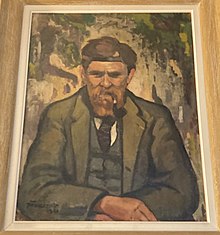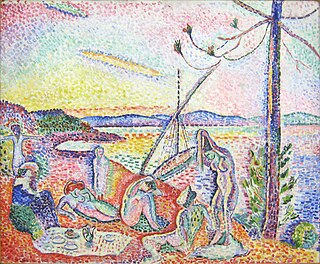Alfred Veillet | |
|---|---|
 Alfred Veillet par Jean Texier (1924) | |
| Born | March 2, 1882 Ézy-sur-Eure, France |
| Died | April 9, 1958 (aged 76) |
Alfred Veillet (March 2, 1882 - April 9, 1958) [1] was a French painter.
Alfred Veillet | |
|---|---|
 Alfred Veillet par Jean Texier (1924) | |
| Born | March 2, 1882 Ézy-sur-Eure, France |
| Died | April 9, 1958 (aged 76) |
Alfred Veillet (March 2, 1882 - April 9, 1958) [1] was a French painter.
Born in Ézy-sur-Eure from Jean Léon Veillet, painter worker, and Clémence Marquis, housewife, he began his professional career in 1898 as a worker painter in Bonnières-sur-Seine. Having become a qualified decorator, the chance of an order led him to Percival Rosseau, painter American established in Rolleboise, to whom he showed his first paintings. The latter introduced him to his compatriot and neighbor Daniel Ridgway Knight, painter naturalist and great admirer of Corot, as Veillet. [1] These contacts encouraged him to continue his artistic activity.
In 1905, he made the acquaintance of the painter Maximilien Luce during the independent living room in Paris, bought him two landscapes, and became friends with him. [2] He convinced him in 1920 to buy a house in Rolleboise, not far from his. [3] [4]
That same year he sent his first painting to the Salon des Indépendants, in which he regularly participated throughout his life. In 1906, he set up on his own in Freneuse, then in 1913 in Rolleboise. Besides Maximilien Luce, Ridgway Knight, Percival Rosseau, he also frequents Georgette Agutte, Herbert Ward, Jean Texcier. [2] and more occasionally Paul Signac, Albert Dagnaux, Charles Angrand. Participating in numerous fairs and exhibitions, he is recognized by art critics such as Apollinaire, André Warnod or Roger Allard. [1]
When the First World War struck, although reformed due to poor health, he enlisted as a voluntary combatant with the rank of corporal, took part in various battles, but was seriously wounded in the head on July 2, 1917 at Chemin des Dames. This will earn him several quotes and several decorations. After having been trepanned, hospitalized for a year, he remains war disabled, suffering from headaches, dizziness, dysmnesia and partial deafness., [5] [2] [6] but he nevertheless continues to exercise his art. [1]
He was deputy mayor of Rolleboise, Yvelines, and in 1937, was elected borough councilor of Bonnières-sur-Seine. [1]
On April 9, 1958, he died in Rolleboise, where he was buried. [1]
In their Dictionary of the little masters, Gérald Schurr and Pierre Cabanne describe the talents of Alfred Veillet as follows:
Attentive to the spectacles of water and the sky, Veillet is an endearing Post-Impressionist, full of verve and poetry, sometimes showing a certain melancholy in front of a nature whose fleeting character he apprehends. He exhibited at the Salon des Indépendants where Apollinaire noticed him and judged, in 1914, that his landscapes were “delicate like the sites of Sequania which inspired them” [15]
His favorite technique is oil painting, and his subjects are mostly landscapes without people where water dominates: banks of the Seine, ponds, lakes, bridges, seaside, ports... called himself "the last impressionist of the 20th century". [4]
He receives successively the following decorations: [5]
His name was given to a street in Ézy-sur-Eure, his hometown. [18]

Yvelines is a department in the western part of the Île-de-France region in Northern France. In 2019, it had a population of 1,448,207. Its prefecture is Versailles, home to the Palace of Versailles, the principal residence of the King of France from 1682 until 1789, a UNESCO World Heritage Site since 1979. Yvelines' subprefectures are Saint-Germain-en-Laye, Mantes-la-Jolie and Rambouillet.

Pointillism is a technique of painting in which small, distinct dots of color are applied in patterns to form an image.

Mantes-la-Jolie is a commune in the Yvelines department in the Île-de-France region of north-central France. It is located to the west of Paris, 48.4 km (30.1 mi) from the centre of the capital. Mantes-la-Jolie is a subprefecture of Yvelines.

Henri-Edmond Cross, born Henri-Edmond-Joseph Delacroix, was a French painter and printmaker. He is most acclaimed as a master of Neo-Impressionism and he played an important role in shaping the second phase of that movement. He was a significant influence on Henri Matisse and many other artists. His work was instrumental in the development of Fauvism.

Maximilien Luce was a prolific French Neo-impressionist artist, known for his paintings, illustrations, engravings, and graphic art, and also for his anarchist activism. Starting as an engraver, he then concentrated on painting, first as an Impressionist, then as a Pointillist, and finally returning to Impressionism.

Neo-Impressionism is a term coined by French art critic Félix Fénéon in 1886 to describe an art movement founded by Georges Seurat. Seurat's most renowned masterpiece, A Sunday Afternoon on the Island of La Grande Jatte, marked the beginning of this movement when it first made its appearance at an exhibition of the Société des Artistes Indépendants in Paris. Around this time, the peak of France's modern era emerged and many painters were in search of new methods. Followers of Neo-Impressionism, in particular, were drawn to modern urban scenes as well as landscapes and seashores. Science-based interpretation of lines and colors influenced Neo-Impressionists' characterization of their own contemporary art. The Pointillist and Divisionist techniques are often mentioned in this context, because they were the dominant techniques in the beginning of the Neo-Impressionist movement.

Albert Dubois-Pillet was a French Neo-impressionist painter and a career army officer. He was instrumental in the founding of the Société des Artistes Indépendants, and was one of the first artists to embrace Pointillism.

The Société des Artistes Indépendants or Salon des Indépendants was formed in Paris on 29 July 1884. The association began with the organization of massive exhibitions in Paris, choosing the slogan "sans jury ni récompense". Albert Dubois-Pillet, Odilon Redon, Georges Seurat and Paul Signac were among its founders. For the following three decades their annual exhibitions set the trends in art of the early 20th century, along with the Salon d'Automne. This is where artworks were often first displayed and widely discussed. World War I brought a closure to the salon, though the Artistes Indépendants remained active. Since 1920, the headquarters has been located in the vast basements of the Grand Palais.

Charles Angrand was a French artist who gained renown for his Neo-Impressionist paintings and drawings. He was an important member of the Parisian avant-garde art scene in the late 1880s and early 1890s.

Maurice Boitel was a French painter.

The arrondissement of Mantes-la-Jolie is an arrondissement of France in the Yvelines department in the Île-de-France region. It has 109 communes. Its population is 276,911 (2019), and its area is 759.0 km2 (293.1 sq mi).

Divisionism, also called chromoluminarism, is the characteristic style in Neo-Impressionist painting defined by the separation of colors into individual dots or patches that interact optically.

Jacques Gay was a French painter.

Fauvism is a style of painting and an art movement that emerged in France at the beginning of the 20th century. It was the style of les Fauves, a group of modern artists whose works emphasized painterly qualities and strong colour over the representational or realistic values retained by Impressionism. While Fauvism as a style began around 1904 and continued beyond 1910, the movement as such lasted only a few years, 1905–1908, and had three exhibitions. The leaders of the movement were André Derain and Henri Matisse.

Robert Antoine Pinchon was a French Post-Impressionist landscape painter of the Rouen School who was born and spent most of his life in France. He was consistent throughout his career in his dedication to painting landscapes en plein air. From the age of nineteen he worked in a Fauve style but never deviated into Cubism, and, unlike others, never found that Post-Impressionism did not fulfill his artistic needs. Claude Monet referred to him as "a surprising touch in the service of a surprising eye".
The Communauté d'agglomération de Mantes-en-Yvelines is a former administrative entity in the Yvelines département, near Paris. Its administrative center was Mantes-la-Jolie. It was created in December 1999. It was merged into the Communauté urbaine Grand Paris Seine et Oise in January 2016.

Albert Lebourg, birth name Albert-Marie Lebourg, also called Albert-Charles Lebourg and Charles Albert Lebourg, was a French Impressionist and Post-Impressionist landscape painter of the Rouen School. Member of the Société des Artistes Français, he actively worked in a luminous Impressionist style, creating more than 2,000 landscapes during his lifetime. The artist was represented by Galerie Mancini in Paris in 1896, in 1899 and 1910 by : Galerie Bernheim-Jeune, 1903 and 1906 at the Galerie Paul Rosenberg, and 1918 and 1923 at Galerie Georges Petit.

Jeanne-Henriette Tirman was a French woman painter and printmaker.

The Communauté urbaine Grand Paris Seine et Oise is the communauté urbaine, an intercommunal structure, covering the western suburbs of Paris. It is located in the Yvelines department, in the Île-de-France region, northern France. It was created in January 2016 by the merger of the previous communautés d'agglomération Mantes-en-Yvelines, Deux Rives de la Seine, Poissy-Achères-Conflans-Sainte-Honorine, Seine & Vexin and the communautés de communes Coteaux du Vexin and Seine-Mauldre. Its area is 504.7 km2. Its population was 417,556 in 2018. Its seat is in Aubergenville.
Henri Jean Pontoy was a French painter. His work was part of the painting event in the art competition at the 1924 Summer Olympics.
Biography of Veillet, friendship with Luce and Texcier, war.
Alfred Veillet model of Luce for The station of the East under the snow.
Alfred Veillet: online presentation p. 106-107.
{{cite book}}: |work= ignored (help)